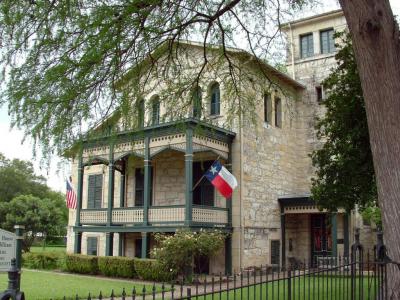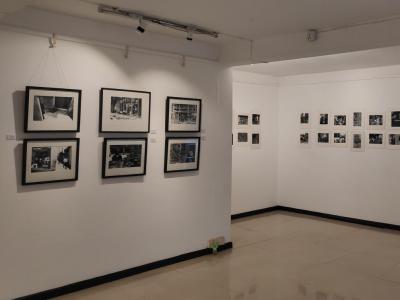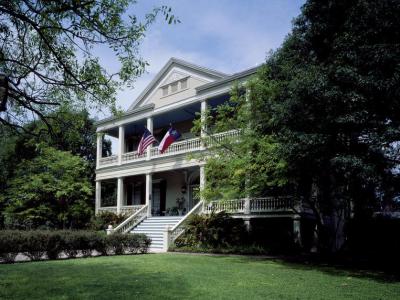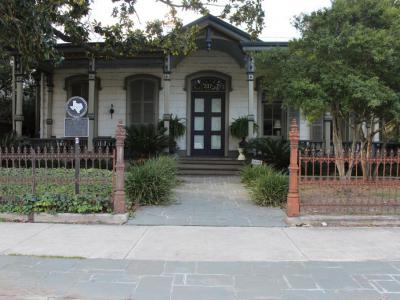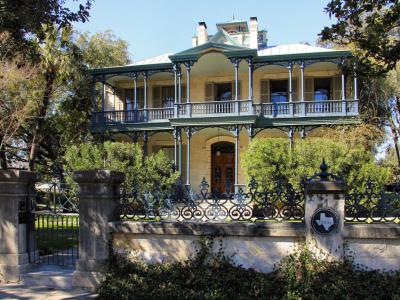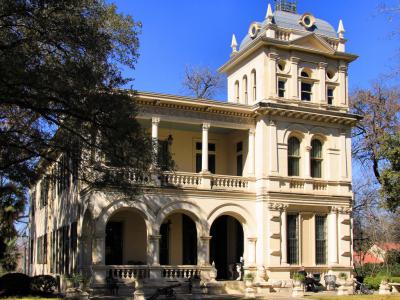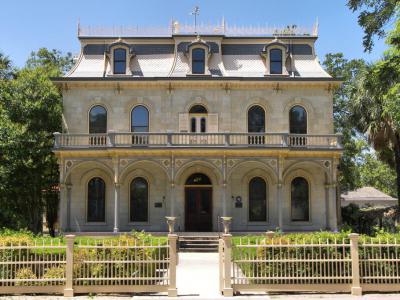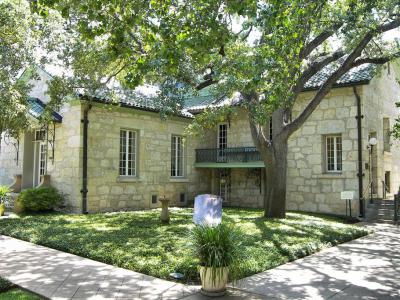King William Historical District Tour (Self Guided), San Antonio
San Antonio’s first “suburb” and the very first historical district in Texas, revitalized during the 1960s, the King William District encompasses 25 blocks south of downtown and east of the San Antonio River.
Back in the late 1800s, it was the most elegant residential area in the city. Settled by German immigrants, the neighborhood was named after Kaiser Wilhelm of Prussia and represented their achievements as they prospered and built opulent mansions.
Steeped in architectural beauty, this district boasts a collection of well-preserved 19th-century homes, notable for their style, many of which today have been converted into museums and cultural centers.
Among such notable landmarks is the Anton Wulff House, a stunning example of German Renaissance Revival architecture. Nearby, the San Antonio Art League Museum showcases works by local and regional artists, providing insight into the city's vibrant art scene.
The Oge House, Sartor House, and Carl Wilhelm August Groos House offer glimpses into the lives of prominent residents from the past, while the Norton–Polk–Mathis House and Steves Homestead Museum provide further opportunities to explore the district's history.
Be sure to visit the Guenther House, a beloved local spot known for its delicious baked goods and historic ambiance.
For anyone interested in experiencing the rich history and cultural heritage of San Antonio, a visit to the King William Historical District is a must. Wander the tree-lined streets, admire the architecture, and immerse yourself in the stories of generations past!
Back in the late 1800s, it was the most elegant residential area in the city. Settled by German immigrants, the neighborhood was named after Kaiser Wilhelm of Prussia and represented their achievements as they prospered and built opulent mansions.
Steeped in architectural beauty, this district boasts a collection of well-preserved 19th-century homes, notable for their style, many of which today have been converted into museums and cultural centers.
Among such notable landmarks is the Anton Wulff House, a stunning example of German Renaissance Revival architecture. Nearby, the San Antonio Art League Museum showcases works by local and regional artists, providing insight into the city's vibrant art scene.
The Oge House, Sartor House, and Carl Wilhelm August Groos House offer glimpses into the lives of prominent residents from the past, while the Norton–Polk–Mathis House and Steves Homestead Museum provide further opportunities to explore the district's history.
Be sure to visit the Guenther House, a beloved local spot known for its delicious baked goods and historic ambiance.
For anyone interested in experiencing the rich history and cultural heritage of San Antonio, a visit to the King William Historical District is a must. Wander the tree-lined streets, admire the architecture, and immerse yourself in the stories of generations past!
How it works: Download the app "GPSmyCity: Walks in 1K+ Cities" from Apple App Store or Google Play Store to your mobile phone or tablet. The app turns your mobile device into a personal tour guide and its built-in GPS navigation functions guide you from one tour stop to next. The app works offline, so no data plan is needed when traveling abroad.
King William Historical District Tour Map
Guide Name: King William Historical District Tour
Guide Location: USA » San Antonio (See other walking tours in San Antonio)
Guide Type: Self-guided Walking Tour (Sightseeing)
# of Attractions: 8
Tour Duration: 1 Hour(s)
Travel Distance: 1.1 Km or 0.7 Miles
Author: DanaOffice
Sight(s) Featured in This Guide:
Guide Location: USA » San Antonio (See other walking tours in San Antonio)
Guide Type: Self-guided Walking Tour (Sightseeing)
# of Attractions: 8
Tour Duration: 1 Hour(s)
Travel Distance: 1.1 Km or 0.7 Miles
Author: DanaOffice
Sight(s) Featured in This Guide:
- Anton Wulff House
- San Antonio Art League Museum
- Oge House
- Sartor House
- Carl Wilhelm August Groos House
- Norton–Polk–Mathis House
- Steves Homestead Museum
- Guenther House
1) Anton Wulff House
The Anton Wulff House, located on King William Street in San Antonio, stands as a testament to the city’s rich history and cultural evolution. Constructed between 1869 and 1870, the multi-story Italianate limestone residence was commissioned by German immigrant and influential San Antonio figure, Anton Friedrich Wulff. This historic landmark is situated within the King William Historic District and has been designated both a Recorded Texas Historic Landmark and a contributing structure on the National Register of Historic Places in Bexar County.
Anton Wulff, a native of Hamburg, Germany, immigrated to Texas in 1848. A visionary businessman, Wulff played a pivotal role in San Antonio's development, serving as the city’s first park commissioner and as an alderman. Notably, he designed the layout of Alamo Plaza, beautifying the space with his passion for horticulture and often funding improvements himself. His civic contributions earned him a gold-topped walking cane from the city’s business leaders as a token of appreciation.
The Wulff House, once part of Pedro Huizar's land at the San Antonio de Valero Mission, was a picturesque estate by the San Antonio River. Flooding in 1921 prompted the river's re-routing in 1926, altering the property's surroundings. After changing hands multiple times-serving as apartments in 1950 and later owned by the United Brotherhood of Carpenters-it gained historical zoning in 1968. The San Antonio Conservation Society purchased it in 1974, using it as their headquarters until 2022. The nearby Pedro Huizar Garden honors the area's history.
Today, the Anton Wulff House is celebrated not only for its architectural beauty but also for its association with a man who shaped much of San Antonio's civic and cultural landscape. Its storied past, from Wulff’s resilience during the Civil War to its role as a preservationist headquarters, makes it a cornerstone of San Antonio’s heritage.
Anton Wulff, a native of Hamburg, Germany, immigrated to Texas in 1848. A visionary businessman, Wulff played a pivotal role in San Antonio's development, serving as the city’s first park commissioner and as an alderman. Notably, he designed the layout of Alamo Plaza, beautifying the space with his passion for horticulture and often funding improvements himself. His civic contributions earned him a gold-topped walking cane from the city’s business leaders as a token of appreciation.
The Wulff House, once part of Pedro Huizar's land at the San Antonio de Valero Mission, was a picturesque estate by the San Antonio River. Flooding in 1921 prompted the river's re-routing in 1926, altering the property's surroundings. After changing hands multiple times-serving as apartments in 1950 and later owned by the United Brotherhood of Carpenters-it gained historical zoning in 1968. The San Antonio Conservation Society purchased it in 1974, using it as their headquarters until 2022. The nearby Pedro Huizar Garden honors the area's history.
Today, the Anton Wulff House is celebrated not only for its architectural beauty but also for its association with a man who shaped much of San Antonio's civic and cultural landscape. Its storied past, from Wulff’s resilience during the Civil War to its role as a preservationist headquarters, makes it a cornerstone of San Antonio’s heritage.
2) San Antonio Art League Museum
The San Antonio Art League & Museum (SAALM) is the oldest arts institution in San Antonio. The League's location changed many times until, after a long struggle and some moving around, it was finally given the opportunity to settle in a venerable building in the heart of the historic King William District.
Visitors to the SAALM often ask about its building, and are often surprised to find out that, although it was built in 1896, it has a very non-Victorian "pedigree". The intimate house-turned-museum and gallery today houses over 600 works in its permanent collection, and is mainly focused on local and regional art, featuring works in all media - including paintings, drawings, prints and photographs, furniture, ceramics and sculpture - available for public viewing. The heart of the collection are the paintings from the Edgar B. Davis Texas Wildflower Competitive Exhibitions dating back to the 1920s.
The San Antonio Art League was organized in March 13, 1912. Among the notable Texan artists represented in its diverse and highly respected collection are Robert and Julian Onderdonk, José Arpa, Emma Richardson Cherry, E. G. Eisenlohr, Mary Bonner, Martha Mood, Charles Umlauf, and Amy Freeman Lee. Revolving contemporary exhibits displayed at SAALM also represent the unique diversity of Texas talent.
Visitors to the SAALM often ask about its building, and are often surprised to find out that, although it was built in 1896, it has a very non-Victorian "pedigree". The intimate house-turned-museum and gallery today houses over 600 works in its permanent collection, and is mainly focused on local and regional art, featuring works in all media - including paintings, drawings, prints and photographs, furniture, ceramics and sculpture - available for public viewing. The heart of the collection are the paintings from the Edgar B. Davis Texas Wildflower Competitive Exhibitions dating back to the 1920s.
The San Antonio Art League was organized in March 13, 1912. Among the notable Texan artists represented in its diverse and highly respected collection are Robert and Julian Onderdonk, José Arpa, Emma Richardson Cherry, E. G. Eisenlohr, Mary Bonner, Martha Mood, Charles Umlauf, and Amy Freeman Lee. Revolving contemporary exhibits displayed at SAALM also represent the unique diversity of Texas talent.
3) Oge House
One of the only houses within the King William District not built by German immigrants, the Newton Mitchell or Oge House is also the most important of the three fine residences found on the one-block-long Washington Street. This imposing two-story late Greek Revival edifice was built by the U.S. Army as the commanding officer's quarters for the San Antonio Arsenal in 1860, and is one of the early stone residences in the city. Its first floor and basement date back as far as 1857 when the place was owned by Attorney Newton. A. Mitchell and his wife Catherine (Elder).
The exquisite Neo-Classical antebellum mansion sits on 1.5 acres of land overlooking the famed San Antonio River Walk, surrounded by lush plantings, rose gardens and lawns. Louis Oge (1832-1915) bought this property in 1881, after migrating to Texas in 1845 with the Castor Colony, serving in Texas Rangers under W.A.A. ("Bigfoot") Wallace, and making a fortune as a rancher. He was a San Antonio business leader and served as alderman and school board president. Oge hired a leading local architect Alfred Giles to enlarge and remodel the building.
Today, the Oge House forms part of Noble Inns, a collection of three distinguished San Antonio bed-and-breakfast properties in the heart of the hot Southtown dining scene. Lovingly restored, it features 10 elegant guest rooms on three floors offering all the modern amenities to discerning travelers.
The exquisite Neo-Classical antebellum mansion sits on 1.5 acres of land overlooking the famed San Antonio River Walk, surrounded by lush plantings, rose gardens and lawns. Louis Oge (1832-1915) bought this property in 1881, after migrating to Texas in 1845 with the Castor Colony, serving in Texas Rangers under W.A.A. ("Bigfoot") Wallace, and making a fortune as a rancher. He was a San Antonio business leader and served as alderman and school board president. Oge hired a leading local architect Alfred Giles to enlarge and remodel the building.
Today, the Oge House forms part of Noble Inns, a collection of three distinguished San Antonio bed-and-breakfast properties in the heart of the hot Southtown dining scene. Lovingly restored, it features 10 elegant guest rooms on three floors offering all the modern amenities to discerning travelers.
4) Sartor House
This gem of a house was designed by Alfred Giles for prominent jeweler Alexander Sartor, Jr. in 1881. Though best known for his larger commissions, Alfred Giles, the most popular architect in San Antonio at that time, also created some delightful small-scale works, such as this one.
While many of the homes in this area have highly decorative porches, the Sartor House is unique in its details that are well worth noting. An outstanding example of a typical San Antonio Victorian-era residence, this home features a wide front porch with street-front Italianate detailing which includes five large windows opening onto a handsome deep frame veranda. The soft caliche block walls are stuccoed to imitate ashlar masonry with protruding mortar joints. The central, front porch pediment with hanging pendant, that frames the front door, reflects the Gothic influence. Arched openings, dentil molding and decorative porch elements further mark the Victorian style.
A native of Germany, Sartor came to San Antonio in the mid-19th century. He was a popular watch repairman and had one of the first jewelry stores open in the city. Mr. Sartor lived in this house with his family until 1909. After he had sold the house, it was used for a variety of purposes, including a medical office and a literary studio.
From the 1950s, the house belonged to the Tobin Foundation and was used by the Family Welfare Association, and later as a guesthouse for Hemisfair visitors. In 1973, the property was sold again and underwent a thorough restoration. The new owner is said to have sold old jewelry and gold coins to buy the house. In the late 1970s, she added to it the ornate antique iron fence, a gift from her son-in-law.
While many of the homes in this area have highly decorative porches, the Sartor House is unique in its details that are well worth noting. An outstanding example of a typical San Antonio Victorian-era residence, this home features a wide front porch with street-front Italianate detailing which includes five large windows opening onto a handsome deep frame veranda. The soft caliche block walls are stuccoed to imitate ashlar masonry with protruding mortar joints. The central, front porch pediment with hanging pendant, that frames the front door, reflects the Gothic influence. Arched openings, dentil molding and decorative porch elements further mark the Victorian style.
A native of Germany, Sartor came to San Antonio in the mid-19th century. He was a popular watch repairman and had one of the first jewelry stores open in the city. Mr. Sartor lived in this house with his family until 1909. After he had sold the house, it was used for a variety of purposes, including a medical office and a literary studio.
From the 1950s, the house belonged to the Tobin Foundation and was used by the Family Welfare Association, and later as a guesthouse for Hemisfair visitors. In 1973, the property was sold again and underwent a thorough restoration. The new owner is said to have sold old jewelry and gold coins to buy the house. In the late 1970s, she added to it the ornate antique iron fence, a gift from her son-in-law.
5) Carl Wilhelm August Groos House
The Carl Wilhelm August Groos House in San Antonio is a striking example of Victorian Gothic Revival architecture, designed in 1880 by renowned architect Alfred Giles and constructed by builder John H. Kampmann. This cream-colored limestone mansion, situated on 0.7 acres along the San Antonio River, was commissioned by Carl Wilhelm August Groos, a German immigrant who moved to Texas in 1848. Groos and his brothers initially established a successful freighting firm in New Braunfels before he relocated to San Antonio in 1872, where he became a founding member of the Groos National Bank.
Distinguished by its elegant blue-green columns, intricate iron detailing, and Corinthian capitals, the two-story home boasts covered porches that reflect the ornate charm of the era. The property is surrounded by a four-foot limestone wall crowned with decorative iron fencing, accessible through an iron gate flanked by limestone piers on King William Street.
The meticulously landscaped grounds adhere to Victorian principles of symmetry and order, featuring a central stone-paved walkway that divides the lawn into four quadrants. The lush greenery includes live oaks, Texas sabal palms, and decorative crape myrtles. The northern cul-de-sac of the lawn hosts a circular pool with a fountain centerpiece depicting a cherub surrounded by ferns, adding to the property's stately appeal.
After serving as the Groos family residence until 1948, the house transitioned into various private ownerships, including its acquisition by the San Antonio Council of the Girl Scouts in 1957. It was later restored and remains privately owned. The Carl Wilhelm August Groos House, recognized as a Recorded Texas Historic Landmark in 1977, is a contributing structure within the King William Historic District, which was listed on the National Register of Historic Places in 1972. Its rich history and architectural splendor make it a treasured landmark in San Antonio.
Distinguished by its elegant blue-green columns, intricate iron detailing, and Corinthian capitals, the two-story home boasts covered porches that reflect the ornate charm of the era. The property is surrounded by a four-foot limestone wall crowned with decorative iron fencing, accessible through an iron gate flanked by limestone piers on King William Street.
The meticulously landscaped grounds adhere to Victorian principles of symmetry and order, featuring a central stone-paved walkway that divides the lawn into four quadrants. The lush greenery includes live oaks, Texas sabal palms, and decorative crape myrtles. The northern cul-de-sac of the lawn hosts a circular pool with a fountain centerpiece depicting a cherub surrounded by ferns, adding to the property's stately appeal.
After serving as the Groos family residence until 1948, the house transitioned into various private ownerships, including its acquisition by the San Antonio Council of the Girl Scouts in 1957. It was later restored and remains privately owned. The Carl Wilhelm August Groos House, recognized as a Recorded Texas Historic Landmark in 1977, is a contributing structure within the King William Historic District, which was listed on the National Register of Historic Places in 1972. Its rich history and architectural splendor make it a treasured landmark in San Antonio.
6) Norton–Polk–Mathis House
The Norton–Polk–Mathis House, widely known as Villa Finale, stands as a historic treasure in San Antonio's King William Historical District. Constructed on one of the area's oldest sites, the property reflects a rich evolution of Texas architecture while embodying the vibrant history of its neighborhood.
The story began in 1869, when Russell C. Norton, a San Antonio merchant and Mayflower descendant, acquired three lots of land stretching from King William Street to the San Antonio River. In 1876, he began constructing the house, which underwent multiple remodels over the 19th century. These transformations included the addition of a second story, a Victorian gingerbread rear gallery, and eventually an Italian Renaissance Revival tower and porch, making the house a living timeline of architectural styles.
Through a succession of owners, the property fell into disrepair and was eventually used as a boarding residence until 1967. At that time, Walter Nold Mathis, a prominent civic leader, purchased the house. Mathis meticulously restored it to its original grandeur over two years, naming it Villa Finale as a testament to his intention to make it his final home. His efforts extended beyond his residence: Mathis acquired and stabilized 16 additional properties in the King William neighborhood, earning him the title of "father of the modern King William."
In 1971, the Norton–Polk–Mathis House was recognized as a Recorded Texas Historic Landmark and became a contributing property to the King William Historic District, which is listed on the National Register of Historic Places. Upon Mathis’s death in 2005, he bequeathed the home to the National Trust for Historic Preservation. Today, the house operates as a museum, offering visitors a glimpse into its layered history and the architectural heritage of Texas. Tours are available on a limited basis, preserving Mathis's legacy and the unique charm of Villa Finale.
The story began in 1869, when Russell C. Norton, a San Antonio merchant and Mayflower descendant, acquired three lots of land stretching from King William Street to the San Antonio River. In 1876, he began constructing the house, which underwent multiple remodels over the 19th century. These transformations included the addition of a second story, a Victorian gingerbread rear gallery, and eventually an Italian Renaissance Revival tower and porch, making the house a living timeline of architectural styles.
Through a succession of owners, the property fell into disrepair and was eventually used as a boarding residence until 1967. At that time, Walter Nold Mathis, a prominent civic leader, purchased the house. Mathis meticulously restored it to its original grandeur over two years, naming it Villa Finale as a testament to his intention to make it his final home. His efforts extended beyond his residence: Mathis acquired and stabilized 16 additional properties in the King William neighborhood, earning him the title of "father of the modern King William."
In 1971, the Norton–Polk–Mathis House was recognized as a Recorded Texas Historic Landmark and became a contributing property to the King William Historic District, which is listed on the National Register of Historic Places. Upon Mathis’s death in 2005, he bequeathed the home to the National Trust for Historic Preservation. Today, the house operates as a museum, offering visitors a glimpse into its layered history and the architectural heritage of Texas. Tours are available on a limited basis, preserving Mathis's legacy and the unique charm of Villa Finale.
7) Steves Homestead Museum
The Edward Steves Homestead is the showcase of an immense wealth that was amassed by lumber baron Edward Steves, founder of the Steves Lumber Company, who immigrated to Texas from Germany in 1849. The homestead incorporates an elegant three-story mansion with a concave mansard roof decorated in iron cresting, which is characteristic of the French Second Empire and the Italian Villa styles, plus some out buildings. Made of ashlar limestone (which means “precisely cut and finished”, also known to masons as “peck work”), the Steves mansion was built in 1876, possibly to the design by Alfred Giles, the prominent San Antonio architect.
As for the homestead's out buildings, they include The River House, a one-story brick structure at the rear of the Homestead property, which held one of the earliest natatoriums, or indoor swimming pools, in San Antonio. This brick-lined bit of luxury used to be filled with water from the artesian well located on the property. Mrs. Steves is said to have swam there every day, at two o’clock, regardless of the weather.
To hold storage during the homestead construction, the two-story frame and stone Carriage House was built in 1875, a year before the mansion itself. Thoroughly restored in 1976-1977, the Carriage House still provides storage for the Edward Steves Homestead today.
Once the mansion was complete, servants’ quarters were necessary to house the full-time gardener and a “stable boy” who worked for the Steves family. This was built around 1877. The Servants Quarters was restored in 1983-84 and currently serves as a Visitors Center, where tickets are sold and tours originate.
Listed on the National Register of Historic Places, the homestead remained a family residence until 1952 when Steves’ descendants donated it to the San Antonio Conservation Society who then turned it into a museum in 1954. Visiting this museum today makes one feel back in time at least hundred years.
As for the homestead's out buildings, they include The River House, a one-story brick structure at the rear of the Homestead property, which held one of the earliest natatoriums, or indoor swimming pools, in San Antonio. This brick-lined bit of luxury used to be filled with water from the artesian well located on the property. Mrs. Steves is said to have swam there every day, at two o’clock, regardless of the weather.
To hold storage during the homestead construction, the two-story frame and stone Carriage House was built in 1875, a year before the mansion itself. Thoroughly restored in 1976-1977, the Carriage House still provides storage for the Edward Steves Homestead today.
Once the mansion was complete, servants’ quarters were necessary to house the full-time gardener and a “stable boy” who worked for the Steves family. This was built around 1877. The Servants Quarters was restored in 1983-84 and currently serves as a Visitors Center, where tickets are sold and tours originate.
Listed on the National Register of Historic Places, the homestead remained a family residence until 1952 when Steves’ descendants donated it to the San Antonio Conservation Society who then turned it into a museum in 1954. Visiting this museum today makes one feel back in time at least hundred years.
8) Guenther House
Nestled on East Guenther Street in San Antonio's historic King William neighborhood, the Guenther House is a multifaceted destination combining a restaurant, museum, and store. This charming limestone home, originally built in 1859 by Carl Hilmar Guenther, founder of Pioneer Flour Mills, showcases a blend of historical significance and culinary delights. The property was added to the National Register of Historic Places on October 11, 1990.
Carl Hilmar Guenther (1826–1902), a German-trained millwright, immigrated to the U.S. in 1848 and established a gristmill in San Antonio in 1859, which grew into Pioneer Flour Mills. He built his home near the mill, becoming one of the first residents of the King William Historic District. Renovated in 1915, the Guenther House added a river-facing entrance and transformed its top-floor Roof Garden into an event space. Its patio and arbor now provide a charming outdoor dining experience.
The Guenther House museum preserves the Guenther family legacy, showcasing personal artifacts, milling tools, and relics from the history of baking and dining in San Antonio. Travel souvenirs collected by the family add a global touch to the exhibit. Visitors can explore the museum's former library space and gain insight into the region's cultural and culinary evolution.
The restaurant at the Guenther House serves up American classics with a southern twist. Guests can enjoy breakfast staples like buttermilk biscuits with country sausage gravy and Pioneer Mills pancakes or explore a rotating menu of quiches, soups, salads, and sandwiches for lunch. The historic dining areas, including the original kitchen, tea room, and ballroom-style seating, offer a glimpse into early 20th-century hospitality. Outdoor seating beneath the arbor provides a serene option for alfresco dining.
Whether indulging in a hearty breakfast, exploring milling history, or simply soaking in the ambiance of the King William District, the Guenther House offers a delightful blend of history, culture, and cuisine. Open daily, it continues to be a beloved destination for locals and visitors alike.
Carl Hilmar Guenther (1826–1902), a German-trained millwright, immigrated to the U.S. in 1848 and established a gristmill in San Antonio in 1859, which grew into Pioneer Flour Mills. He built his home near the mill, becoming one of the first residents of the King William Historic District. Renovated in 1915, the Guenther House added a river-facing entrance and transformed its top-floor Roof Garden into an event space. Its patio and arbor now provide a charming outdoor dining experience.
The Guenther House museum preserves the Guenther family legacy, showcasing personal artifacts, milling tools, and relics from the history of baking and dining in San Antonio. Travel souvenirs collected by the family add a global touch to the exhibit. Visitors can explore the museum's former library space and gain insight into the region's cultural and culinary evolution.
The restaurant at the Guenther House serves up American classics with a southern twist. Guests can enjoy breakfast staples like buttermilk biscuits with country sausage gravy and Pioneer Mills pancakes or explore a rotating menu of quiches, soups, salads, and sandwiches for lunch. The historic dining areas, including the original kitchen, tea room, and ballroom-style seating, offer a glimpse into early 20th-century hospitality. Outdoor seating beneath the arbor provides a serene option for alfresco dining.
Whether indulging in a hearty breakfast, exploring milling history, or simply soaking in the ambiance of the King William District, the Guenther House offers a delightful blend of history, culture, and cuisine. Open daily, it continues to be a beloved destination for locals and visitors alike.
Walking Tours in San Antonio, Texas
Create Your Own Walk in San Antonio
Creating your own self-guided walk in San Antonio is easy and fun. Choose the city attractions that you want to see and a walk route map will be created just for you. You can even set your hotel as the start point of the walk.
River Walk Tour
The San Antonio River Walk (also known as Paseo del Río or simply The River Walk) is a network of walkways along the banks of the San Antonio River, one story beneath the streets of the city. A successful special-case pedestrian street, this walk winds and loops under bridges as two parallel sidewalks lined with restaurants and shops, connecting major tourist draws and attractions that add to its... view more
Tour Duration: 1 Hour(s)
Travel Distance: 1.9 Km or 1.2 Miles
Tour Duration: 1 Hour(s)
Travel Distance: 1.9 Km or 1.2 Miles
San Antonio Introduction Walking Tour
San Antonio, one of Texas' major cities, boasts rich colonial heritage. The city was named by a 1691 Spanish expedition for Saint Anthony of Padua, whose feast day is June 13. At the time of European encounter, the area near the San Antonio River Valley was inhabited by Payaya Indians who called it Yanaguana, the "refreshing waters".
In 1709, Spanish Father Antonio de Olivares... view more
Tour Duration: 2 Hour(s)
Travel Distance: 3.3 Km or 2.1 Miles
In 1709, Spanish Father Antonio de Olivares... view more
Tour Duration: 2 Hour(s)
Travel Distance: 3.3 Km or 2.1 Miles
The Most Popular Cities
/ view all



